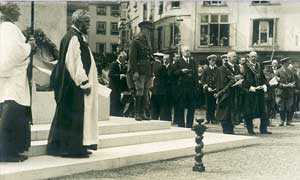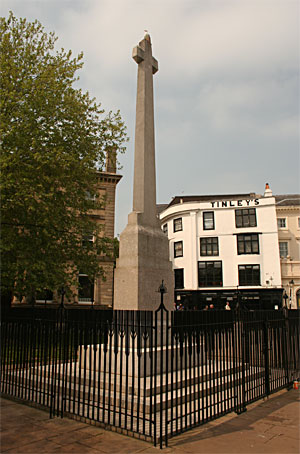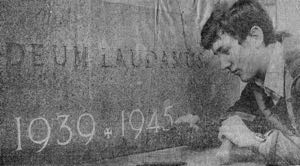
The Devon War Memorial
Page updated 27th April 2017
The Devon War Memorial can be found in Cathedral Yard, close to Broadgate, where it was carefully positioned on a line that runs from the memorial, through the centre of the West Front to the Cathedral's altar. The wide stepped pathway from Broadgate to the West Front is named the Jellicoe Steps. The memorial was designed by the architect Sir Edwin Lutyens, and made out of a single piece of Haytor granite. It is a rather elegant design which reminds one of the many early stone crosses that are found in the south west. The Haytor quarry, which supplied the granite for London Bridge (the one in Arizona!), was reopened in 1919 especially to extract the stone for the memorial.
Lutyens wrote of the memorial "... it is very simple and a monolith and its subtlety in lines means labour, care and thought. It is out of one stone, the biggest I could get.... it should endure for ever".
Unveiled in May 1921, by the Prince of Wales (photo above), the dates for the First War are shown as 1914-1919 as Britain was still at war in Russia during 1919. The Prince said:
"It is a great privilege to me to be in Exeter to-day and a great honour to unveil the Devon county war memorial and to join with you in paying this tribute to the gallant sons of Devon who gave their lives for their King and country since 1914. I think the magnitude of the Great War and what the British effort and sacrifices were is brought home by the fact that the Devonshire Regiment alone sent 50,000 men overseas. That is over double the British forces engaged at the battle of Waterloo, and the casualties of the regiment were also over double what they were in that ancient battle.
I know what this memorial means here in Exeter and Devon, and I feel sure that it will serve as a great inspiration to coming generations to do their best in whatever way they may be called upon and so uphold those splendid traditions which have been handed down by generations of the men of Devon."
The Prince then placed a laurel crown at the base and deposited the roll of honour in a receptacle provided under the cross. Copies were then handed to the Dean and Chapter for preservation in the archives of the Cathedral and to Sir Henry Lopes on behalf of the County of Devon. The service ended with the hymn "O God, our help in ages past" and the Benediction. Afterwards, the Prince walked Cathedral Yard and met troops of the Boy Scouts, Girl Guides and V.A.D. detachments who were standing in ranks on the green. He inspected the ex-service men, shaking each man's hand in turn before returning to the memorial cross for three cheers and hand clapping, before entering his car to continue to Exmouth. The streets of the city were lined with Exonians waving flags and signs saying "You'm welcome, Prince. Us be praper glad to zee-e."
The memorial bears the inscription - "County of Devon. To her glorious dead, 1914-1919. Te Deum laudamus."
Sir Edwin Lutyens was principle architect for New Delhi and designer of the Cenotaph in London, as well as two important projects in Devon – the Drum Inn in Cockington, Torquay (1936), and Castle Drogo on the edge of Dartmoor (1910-1930), which is said to be the last castle to be built in England.
The Second World War was not remembered until 1979. Laurence Beckfodr, an 18 year old apprentice who worked for Herbert Read, when they had moved out of the city to Ebford, was given the task of carving '1939 + 1945' into the granite. The cost was met from a 1930 maintenance fund set up by Lord Fortescue.
The War Memorials Trust, in June 2001, donated £50 towards the cost of installing railings around the memorial as a response to anti-social behaviour and vandalism.
A planned move is thwarted
In 2008, the Dean and Chapter proposed to refurbish Cathedral Yard, including moving the Devon War Memorial, and replace the Jellicoe Steps with a narrow sloped path to the West Front. The plan did not receive an enthusiastic reception, with the County and City Council planning committees expressing disapproval. The Twentieth Century Society approached English Heritage with a recommendation that the War Memorial be listed, making it less likely that permission would be given for the move – the memorial was Grade II* listed in April 2009.
Sources: The Times, the Express & Echo, minutes from Devon County Council planning committee, the Twentieth Century Society website, and internet biographies of Lutyens.

The Prince of Wales
unveils the Devon War Memorial.

The railings were placed around the
memorial in 2008.

Laurence Beckford carving the World War 2 inscription in 1979.
│ Top of Page │